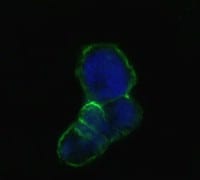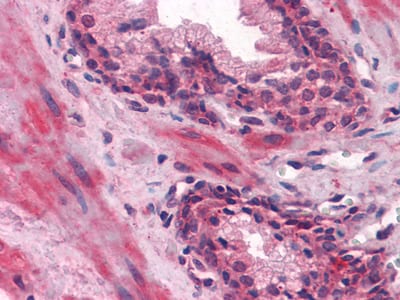

| WB | 咨询技术 | Human,Mouse,Rat |
| IF | 咨询技术 | Human,Mouse,Rat |
| IHC | 1/200 - 1/1000 | Human,Mouse,Rat |
| ICC | 1/200 - 1/1000 | Human,Mouse,Rat |
| FCM | 咨询技术 | Human,Mouse,Rat |
| Elisa | 1/10000 | Human,Mouse,Rat |
| Aliases | TP; PMFA; VEGP |
| Entrez GeneID | 3933 |
| clone | 10B10 |
| WB Predicted band size | 19.2kDa |
| Host/Isotype | Mouse IgG1 |
| Antibody Type | Primary antibody |
| Storage | Store at 4°C short term. Aliquot and store at -20°C long term. Avoid freeze/thaw cycles. |
| Species Reactivity | Human |
| Immunogen | Purified recombinant fragment of LCN1 expressed in E. Coli. |
| Formulation | Ascitic fluid containing 0.03% sodium azide. |
+ +
以下是3篇涉及LCN1(Lipocalin-1)抗体的研究文献摘要概括:
---
1. **文献名称**: *Autoantibodies against lipocalin 1 in Sjögren's syndrome*
**作者**: Saito K, et al.
**摘要**: 该研究发现干燥综合征(Sjögren's syndrome)患者血清中存在抗LCN1的自身抗体,并通过ELISA和免疫印迹验证其特异性。研究提示LCN1抗体可能与泪液分泌减少导致的干眼症状相关。
---
2. **文献名称**: *Lipocalin-1 as a potential biomarker for breast cancer detection*
**作者**: Zhang Y, et al.
**摘要**: 研究开发了针对LCN1的单克隆抗体,用于检测乳腺癌患者体液中的LCN1蛋白水平。结果表明LCN1高表达与肿瘤进展相关,抗体检测具有较高灵敏度和诊断价值。
---
3. **文献名称**: *Structural characterization of lipocalin-1 and its interaction with antibodies*
**作者**: Redl B, et al.
**摘要**: 通过X射线晶体学解析LCN1的分子结构,并分析其与特定抗体的结合位点。研究揭示了LCN1的抗原表位特征,为开发靶向治疗抗体提供理论基础。
---
如需更多文献,可进一步限定研究领域(如疾病模型或抗体应用方向)。
**Background of LCN1 Antibody**
Lipocalin-1 (LCN1), a member of the lipocalin protein family, is a small secretory glycoprotein primarily expressed in tear fluid, saliva, and other mucosal secretions. It plays roles in binding and transporting hydrophobic molecules (e.g., lipids, steroids) and exhibits antimicrobial properties by sequestering iron-bound siderophores, limiting bacterial growth. LCN1 is also implicated in maintaining ocular surface homeostasis and modulating inflammatory responses.
LCN1 antibodies are immunological tools designed to detect and quantify LCN1 in research or diagnostic settings. These antibodies are generated using purified LCN1 protein or peptide antigens, enabling applications like Western blotting, immunohistochemistry, and ELISA. Studies utilizing LCN1 antibodies have explored its involvement in diseases such as Sjögren’s syndrome (reduced tear LCN1 levels), dry eye disease, and certain cancers. Additionally, structural analyses of LCN1-antibody interactions have provided insights into its ligand-binding domains and functional mechanisms.
As a biomarker, LCN1 and its antibodies hold potential for diagnosing secretory disorders or monitoring therapeutic responses. However, cross-reactivity with homologous lipocalins requires careful validation. Ongoing research aims to clarify LCN1’s pathophysiological roles and therapeutic applications.
×